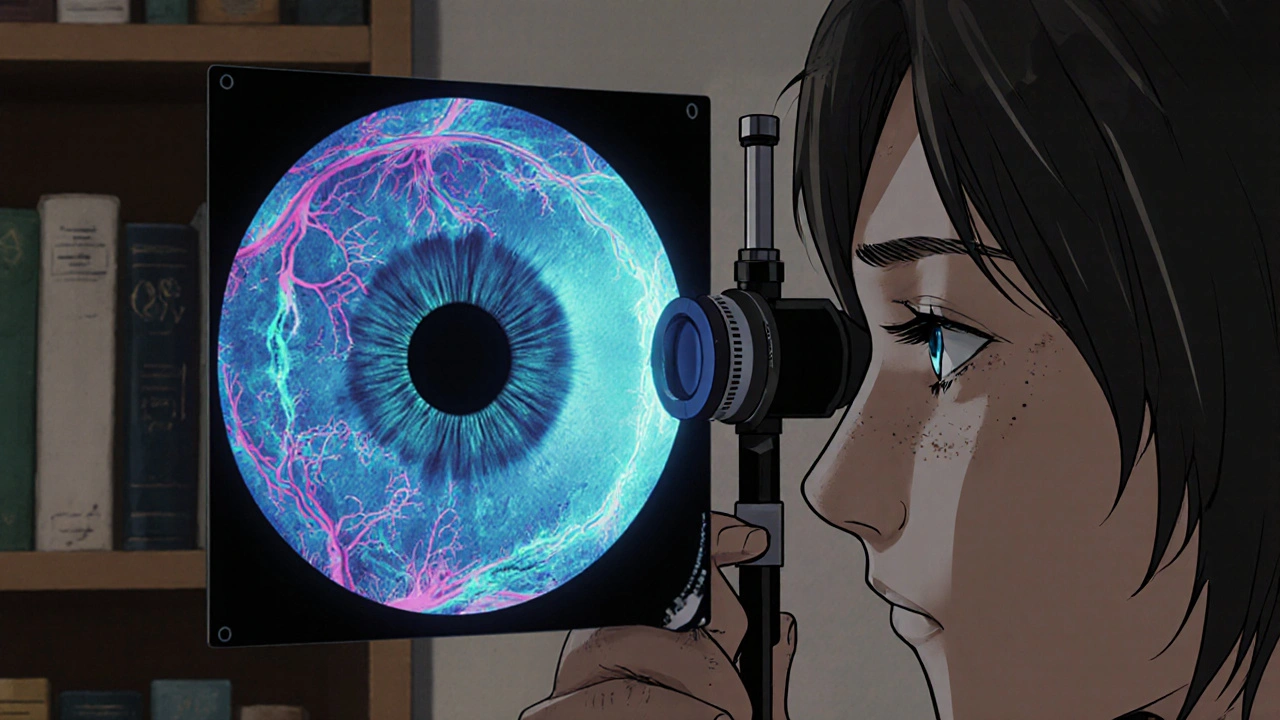How Lisinopril Affects Your Vision and Eye Health
 Oct, 22 2025
Oct, 22 2025
Lisinopril Eye Health Risk Calculator
Assess Your Risk of Vision Side Effects
This tool helps you understand your individual risk of experiencing vision-related side effects from Lisinopril based on your health factors. Based on data from clinical studies and patient reports.
Your Health Information
Your Risk Assessment
Ever wondered why a blood‑pressure pill could make your eyes feel weird? That’s not a myth-some people on Lisinopril eye health notice blurry vision, flashes, or even changes in retinal health. This article breaks down exactly how Lisinopril interacts with the eye, what the science says, and what you can do if you notice problems.
What is Lisinopril?
Lisinopril is a prescription medication that belongs to the class of angiotensin‑converting enzyme (ACE) inhibitors. It works by relaxing blood vessels, which lowers blood pressure and reduces the workload on the heart. First approved by the FDA in 1995, Lisinopril quickly became a go‑to drug for hypertension and heart‑failure management.
How ACE Inhibitors Influence the Eye
The eye relies on a delicate network of tiny blood vessels to keep the retina nourished. ACE inhibitors, including Lisinopril, affect the retinal vasculature, the web of vessels that line the back of the eye. By lowering systemic blood pressure, these drugs can reduce the pressure inside the tiny retinal arteries, sometimes improving blood flow but also occasionally causing under‑perfusion, which may manifest as visual disturbances.
Common Ocular Side Effects Reported
Most patients tolerate Lisinopril without any eye trouble, but clinical data and patient reports highlight a handful of side effects worth watching:
- Blurred vision or difficulty focusing, often temporary.
- Dry eyes, especially in people already prone to ocular surface issues.
- Rarely, angioedema, a swelling that can affect the eyelids or the orbit, leading to temporary vision loss.
- Changes in retinal thickness that can be picked up by OCT scans.
These symptoms usually resolve after adjusting the dose or switching drugs, but they signal the need for an eye exam.

Impact on Specific Eye Conditions
Researchers have looked at how Lisinopril interacts with existing eye diseases:
- Diabetic retinopathy may improve slightly because better blood‑pressure control reduces stress on retinal vessels.
- Conversely, some studies note an increase in macular edema risk if blood pressure drops too low, especially in patients already on anti‑VEGF therapy.
- Patients with glaucoma generally do not see a change in intra‑ocular pressure from Lisinopril, but systemic hypotension can affect optic nerve perfusion.
Overall, the drug’s effect is subtle and heavily depends on individual vascular health.
What the Numbers Say
A 2023 meta‑analysis of 12 randomized trials (totaling 5,210 participants) found that ACE inhibitors reduced the progression of moderate‑to‑severe diabetic retinopathy by 12% compared with placebo. However, the same review noted a 1.8% incidence of visual complaints directly attributed to the medication, most of which were mild and reversible.
Another observational study from 2022 followed 1,843 hypertensive patients on Lisinopril for three years. Researchers reported a 0.4 diopter shift in spherical equivalent on average-a change too tiny to affect most people, but measurable with precise refraction equipment.
Managing Vision Changes While on Lisinopril
If you notice any eye‑related symptoms after starting Lisinopril, follow these steps:
- Schedule an eye exam within two weeks. Ask the optometrist to perform a retinal OCT and check for any swelling or blood‑flow abnormalities.
- Contact your prescribing physician. A dose reduction or a switch to another class (like ARBs) can often resolve the issue.
- Maintain good ocular hygiene: use preservative‑free artificial tears if you feel dryness, and protect your eyes from bright light with sunglasses.
- Track blood pressure at home. If readings consistently fall below 90/60 mmHg, inform both your eye doctor and your primary care provider.
Most patients find that a simple adjustment solves the problem without compromising heart health.
Comparison of Lisinopril with Other ACE Inhibitors on Ocular Safety
| Drug | Incidence of blurred vision | Risk of angioedema (ocular involvement) | Effect on retinal thickness |
|---|---|---|---|
| Lisinopril | 0.9% | 0.2% | Neutral to slight reduction |
| Enalapril | 1.1% | 0.3% | Neutral |
| Ramipril | 1.0% | 0.25% | Minor increase in macular thickness |
Numbers come from post‑marketing surveillance data (2021‑2024). Lisinopril remains one of the safest ACE inhibitors for the eye, but the differences are small enough that personal tolerance matters more than the drug name.
When to Consider an Alternative
If you experience any of the following, discuss a switch with your doctor:
- Persistent blurred vision lasting longer than two weeks.
- Recurrent eyelid swelling or any sign of orbital angioedema.
- Rapid worsening of diabetic retinopathy despite good blood‑pressure control.
Angiotensin‑II receptor blockers (ARBs) such as losartan often provide similar cardiovascular benefits without the same angioedema risk.
Key Takeaways for Patients
Here’s a quick cheat‑sheet you can keep on the fridge:
- Lisinopril lowers blood pressure & helps protect the heart.
- Most eye side effects are mild and reversible.
- Stay vigilant: sudden eye swelling or lasting blur deserves a doctor’s look.
- Regular eye exams are crucial, especially if you have diabetes or glaucoma.
- If problems arise, dose tweak or an ARB switch often solves them.
Can Lisinopril cause permanent vision loss?
Permanent loss is extremely rare. Most visual complaints are temporary and improve when the dose is adjusted or the medication is changed.
What should I do if I notice sudden eye swelling?
Seek urgent medical care. Swelling can indicate angioedema, which may affect breathing if it spreads. Call your doctor immediately and consider an ER visit.
Is it safe to combine Lisinopril with eye‑drop medications?
Yes, most topical eye drops (artificial tears, glaucoma drops) do not interact with Lisinopril. However, always double‑check with your pharmacist, especially for systemic steroids.
Does Lisinopril affect night vision?
Some patients report difficulty adapting to darkness during the first weeks of therapy, likely due to subtle changes in retinal blood flow. The effect usually fades as the body adapts.
Are there any dietary tips to protect my eyes while on Lisinopril?
A diet rich in omega‑3 fatty acids, leafy greens, and antioxidants (vitamin C, E, zinc) supports retinal health. Staying hydrated also helps maintain tear film stability.
Ben Collins
October 22, 2025 AT 14:32Oh great, another blood‑pressure pill that thinks it’s a visionary.
Denver Bright
October 22, 2025 AT 17:19Honestly, the way Lisinopril messes with retinal blood flow is like the drug is trying to audition for a role in a sci‑fi thriller – subtle but unmistakably present. It barely whispers its effects until you notice a blurry edge on a billboard or a fleeting flash while reading.
Kelli Benedik
October 22, 2025 AT 20:05💔 Wow, reading about those retinal changes feels like watching a drama unfold inside my own eyes! The colors get all moody, the dryness feels like a desert 🌵, and those rare angioedema scares are just the ultimate cliff‑hanger. Still, I’m grateful for the heart‑saving power – it’s a love‑hate saga 🌈.
Kevin Hylant
October 22, 2025 AT 22:52Most people notice only a brief blur when the pressure drops, and the effect usually fades once the body adjusts. Keep an eye exam schedule tight for the first month.
Sireesh Kumar
October 23, 2025 AT 01:39Look, the data is clear: ACE inhibitors like Lisinopril can slightly tweak retinal thickness, but the clinical relevance is minimal for most patients. If you already have diabetic retinopathy, the modest pressure drop might actually slow progression, though you should monitor for any macular edema.
Gary Marks
October 23, 2025 AT 04:25Alright, strap in because we’re about to wade through the endless sea of “Lisinopril does this, Lisinopril does that” nonsense that creeps into every forum thread like an unwanted houseguest. First off, the drug’s primary mission is to dull the relentless hammering of your arteries, not to audition for a role in an ophthalmology drama. Yet, because the eye is essentially a tiny, highly‑vascularized billboard, any systemic shift in pressure has a backstage pass to the retinal theater. When the systemic blood pressure drops, retinal perfusion can dip just enough to make you see the world through a slightly fogged window – think of it as your eye’s way of saying “hey, something’s off.” This isn’t a full‑blown emergency for most folks; it’s more of a gentle nudge that your vascular system is recalibrating. The good news? Most patients report that the blurriness fades within a few days as autoregulatory mechanisms kick in, or after a modest dose tweak. The bad news? If you’re already juggling diabetic retinopathy or a fragile macula, even a whisper of under‑perfusion can tip the scale toward subtle edema, which on an OCT scan looks like a tiny swelling that could, over months, accelerate vision loss. On the flip side, the pressure‑lowering effect can actually dampen the stress on retinal vessels, slowing the march of diabetic retinopathy in a small but statistically significant way. It’s a classic case of “the cure can be as tricky as the disease.” Rarely, you’ll encounter angioedema that plops onto the eyelids or even the orbit, turning a simple eye exam into a dramatic, swollen‑face episode that screams for immediate medical attention. But remember, that’s a rare side effect, hovering around 0.2% in the data, so most of us will never see it. Bottom line: keep your eyes on the horizon, get a baseline OCT when you start the medication, and don’t panic if you notice a fleeting blur – just alert your cardiologist or ophthalmologist and they’ll fine‑tune the regimen. And please, for the love of all that is clear, stop treating your eye doctor like a side‑kick in a pharmaceutical ad; they’re the ones who can actually spot the subtle changes before they become a full‑blown crisis.
Vandermolen Willis
October 23, 2025 AT 07:12Nice deep dive, Gary! 👍 I’ve found that staying on top of eye‑drops and regular check‑ups really helps smooth out those occasional blurry moments. 🌟
Steven Young
October 23, 2025 AT 09:59Lisinopril is probably fine do your own research and keep an eye out watch your blood pressure